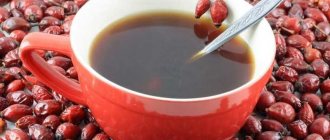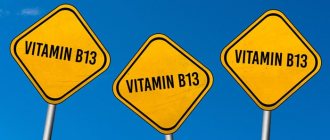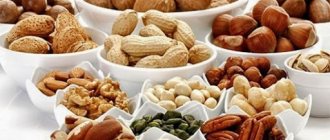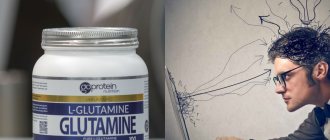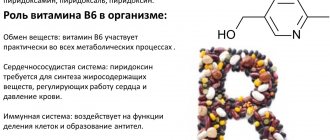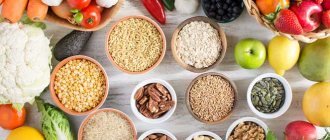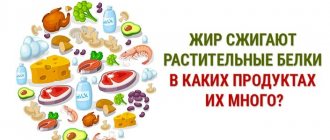Milk fat
The fat content in milk characterizes, first of all, whether the necessary structure of the diet is provided . Since acetic acid, which is formed in the rumen, is mainly responsible for the formation of milk fat, and it is synthesized from plant fiber, it is the sufficient content of hay, haylage, and straw in the diet that is responsible for the normal level of fat content in cow's milk (control of the ratio of bulk feed to concentrated feed, the amount of feed eaten ).
In the first weeks of lactation, fat content indicates whether the animal is getting enough energy. Typically, fat content decreases very sharply from weeks 1 to 4 of lactation, then decreases slightly further by week 10. After this, the fat indicator begins to gradually increase, and this lasts until the start, which indicates that the animal begins to replenish fat reserves (see Figure 1).
Figure 1. Cow productivity and fat and protein levels in milk throughout lactation
High fat content (usually more than 5%) in the first 2-4 weeks after calving indicates intensive mobilization of fat from the cow's body. Often these animals simultaneously have a low protein content in their milk (less than 3.1%). This signals the animal's possible ketosis. As a rule, older animals with a very intense metabolism suffer from this. But animals that were overfed in the previous lactation and during dry periods can also react this way. Typically, the milk yield of such cows increases very sharply in the first weeks of lactation, but they eat little feed. The peak of such ketosis occurs between the 3rd and 5th week of lactation.
Low fat content may be suspected of acidosis, usually due to insufficient diet structure (in the first weeks of lactation, often due to too rapid an increase in the proportion of concentrates or insufficient feed intake in general). A significant decrease in fat in individual animals of greater than 0.4% between two control milkings and a fat to protein ratio below 1.0 may be indicative of acidosis.
The air temperature in the barn above 27°C in combination with high air humidity causes a decrease in the fat content of milk (for the entire herd) by 0.2 - 0.5%. Also, the fat content may decrease due to health problems (liver diseases, parasites, diarrhea, hoof diseases, hormonal disorders).
Relationship between fat content in milk and feeding
| Milk fat content | Feeding errors | Opportunities for improvement |
| very low | insufficient energy supply | improve the quality of basic feed and its palatability; balanced amount of concentrates; check the composition of the feed and how suitable it is; do not overfeed animals at the end of lactation |
| crude fiber content below 18 (16)% or ADF* below 19% in diet dry matter | increase the palatability of the main feed and structured feed; extend feeding time; push/distribute the main feed more often; reduce the amount of concentrates (maximum 50% of the total dry matter of the diet) | |
| poor structural qualities of the main feed | high-quality dried silage, hay and waxy corn silage; improving pastures, reducing the proportion of wet haylage; balance the amount of concentrates in the diet; do not make porridge from the feed in the feed mixer; add 0.5-1.0 kg of straw to the diet | |
| incorrect feeding technique | main food ad libitum; maximum 2 kg of concentrates at a time; same diet morning and evening | |
| quick feed change | change food slowly and smoothly (at least 1 week); especially in spring and autumn; preparatory feeding before calving; gradually increase concentrates after calving | |
| incorrect type, method of preparation and composition of concentrated feed | concentrated feed should be roughly crushed or flattened, with the exception of a fully mixed ration; check the starch and sugar content (maximum 25% in the total diet); reduce the amount of easily digestible starch (wheat, triticale, rye); increase the share of corn in feed; check the fat content in the feed (maximum 5% in the total diet); limit the crown; additives that increase buffering (soda, magnesium oxide); | |
| very high at the beginning of lactation, low at 2 and 3 controls | overfeeding at the end of lactation, lack of energy at the beginning of lactation | limited feeding in the third phase of lactation and dry cows; preparatory feeding before calving; at the beginning of lactation - the best basic food and properly balanced mixed feed; prevention and treatment of ketosis (sodium propionate, propylene glycol, etc.); |
| changes throughout the year | The quality and composition of the main feed are constantly changing | smooth transition from feed to feed; more stable, constant feeding; improvement of pasture management; year-round use of corn silage; feeding hay, especially when grazing animals |
* ADF, KDK – acid detergent fiber (cellulose and lignin)
Whey protein concentrate[edit | edit code]
Manufacturing Process
of Whey Protein Concentrate
is the most beneficial and most common form of whey protein. Whey protein concentrate is considered the most popular sports supplement and is used in bodybuilding to gain muscle mass, lose weight and maintain good physical shape. It is obtained from whey, which remains when making cheese, cottage cheese or casein from milk.
Whey Protein
has three main forms: whey protein concentrate (WPC), whey protein isolate (WPI), and hydrolyzate (WPH).
Whey protein concentrate usually contains some amount of fat, cholesterol and carbohydrates (lactose) - 20% of the product weight or more. Most often, 80% whey protein concentrate is used in sports nutrition, which practically does not lag behind isolates in its beneficial properties. Read more: fast protein, rating of the best proteins.
Approximate composition of one serving (30 g):
- Protein – 24 g
- Carbohydrates - 3 g
- Fats - 2 g
- Cholesterol – 65 mg
- Potassium - 160 mg
- Sodium - 55 mg
- Calcium - 110 mg
- Vitamin A – 200 IU
Protein content of cow's milk
Milk protein is an important indicator of milk quality; modern genetics is aimed at increasing it. And to unlock the full potential of animals, including in obtaining high levels of protein in milk, is the task of production workers.
The protein content of milk reflects whether the cow is well supplied with energy and is a kind of energy barometer for the herd. The level of protein in milk depends on whether the rumen microbes that synthesize microbial protein have enough energy at their disposal. And only with high productivity, protein that is not broken down in the rumen becomes increasingly important. There is a noticeable relationship between animal condition curves and milk protein (Figure 2).
Figure 2. Body condition and protein content of milk in the first 100 days of lactation
Urea in milk is an indicator for checking the supply of rumen microorganisms with nitrogen, the basis of crude protein. A urea content below 15 mg/100 ml of milk indicates a significant nitrogen deficiency in the rumen. This limits the activity of rumen microorganisms, which reduces feed consumption and, as a result, milk production. The protein content of milk in the first two months of lactation changes in the same way as the animal’s body condition. Typically, in the first third of lactation, the protein level in milk decreases with increasing milk yield, since during this period energy is in short supply. During this period, protein above 3.1% is considered normal. But if it falls below 2.8%, this means that the animal no longer has energy reserves in the body. In any case, even with very high milk yields of more than 50 kg per day, the protein content in milk should not fall below 3.1%.
When the animal begins to gain weight again and its condition score increases, the protein level in the milk also increases, and milk yield decreases. In late lactation, milk protein levels of up to 3.8% are considered normal. A protein level above 3.8% signals a significant decrease in productivity. This development is closely related to fat accumulation. In late lactation, milk production is almost independent of body condition if it lies between scores of 3.0 to 3.5. At a higher condition, above a score of 3.5, you need to be prepared for a very sharp decline in productivity in combination with a very high protein value (more than 3.8%).
What are milk proteins?
These are substances consisting of amino acids linked by peptide bonds. They are available in the drink in the form of two types: casein and whey. Whey protein makes up about eighty percent, and casein only twenty percent (of the total composition of the product).
Casein: formed from the mineral calcium. Under the influence of lactic acid bacteria, casein coagulates and precipitates. Thus, products are produced: kefir, yogurt, cottage cheese. This protein takes a long time to digest (about seven hours). It is often used in diets by those people who want to lose excess weight.
Whey contains proteins: albumin and globulin. It is from them that protein-rich products are produced for athletes and young children. These proteins are easily digestible and contain nine important amino acids that our body needs. Whey protein also has the ability to relieve stress. It reduces the level of the hormone cortisone in our body and increases the production of serotonin.
In our country, the most common types of dairy farming are goats and cows. Of course, it is best to purchase natural milk directly from the manufacturer, but not everyone has this opportunity. After all, homemade milk contains the most balanced set of substances beneficial to the body.
But the sight of a cow walking on a green meadow becomes something exotic. In order to make a profit, many large dairy farms use confinement technology. And, of course, for this reason, the product is no longer of the same quality.
Urea in milk
The optimal urea content in cow's milk is about 25 mg/100 ml. Urea more than 30-35 mg/100 ml indicates excess nitrogen and crude protein in the rumen. At the same time, nitrogen metabolism is overloaded.
The amount of urea in milk reflects the nitrogen balance in the rumen, which is used in formulating the diet. The value of rumen nitrogen balance (RNB, BAR) from 0 to 10 g corresponds to a urea content of 20-25 mg/100 ml.
Relationship between protein content in milk and feeding
| Milk protein | Urea in mg/100 ml | Feeding errors | Opportunities for improvement |
| short | less than 15 | insufficient supply of energy, crude protein and intestinal protein | improve the quality of the main feed; increase feed intake; amount of feed in accordance with productivity; increase the content of crude protein in the diet; do not overfeed cows at the end of lactation |
| short | 15-30 | insufficient supply of energy and protein absorbed in the intestines | improve the quality of the main feed; increase the amount of feed consumption; amount of feed in accordance with productivity; use raw materials with a high proportion of protein that is not broken down in the rumen (soybean cake, pumpkin seed cake, brewer's grain corn, dry pulp) |
| short | more than 30-35 | insufficient supply of energy and digestible protein despite excess crude protein | improve the quality of the main feed; increase feed intake; amount of feed in accordance with productivity; use feed rich in energy with a high proportion of protein that is not broken down in the rumen (corn, dry pulp) |
| average | below 15 | lack of crude protein | increase the content of crude protein in the diet; use protein-rich feeds with a high proportion of protein that is not broken down in the rumen |
| average | 15-30 | balanced feeding | no improvement needed |
| average | more than 30-35 | excess crude protein | reduce crude protein content in the diet |
| high | below 15 | excess energy and lack of crude protein | for cows in the last lactation period, reduce the amount of concentrates; reduce the amount of corn silage; use protein-rich raw materials with a high proportion of protein that is not broken down in the rumen |
| high | 15-30 | excess energy | for cows in the last lactation period, reduce the amount of concentrates; reduce the amount of corn silage; increase the hay content |
| high | more than 30-35 | excess energy and protein | for cows in the last lactation period, reduce the amount of concentrates and crude protein; reduce the amount of corn silage |
Fat to protein ratio
The fat and protein levels in milk must be in a certain ratio to each other. A ratio of 1.1:1 to 1.5:1 indicates balanced feeding.
A fat to protein ratio of more than 1.5 , especially at the beginning of lactation (except for the colostrum period) is a warning signal. High fat content is a sign of very strong mobilization of fat from the body. Low protein content indicates a lack of energy, although some of the energy comes from the body's reserves. The consequence of this may be metabolic disorders (ketosis).
If the fat to protein ratio is greater than 1.5 throughout lactation, this indicates a structure-rich but energy-poor feeding. Especially with poor quality bulk feeds and a lack of concentrates. The consequence of this is low milk productivity and low protein content in milk
A very low fat to protein ratio (below 1.1) occurs with a diet that is high in energy and low in structure (lots of concentrates). In this case, it is necessary to correctly distribute the feed in accordance with productivity.
When interpreting the ratio of fat to protein in the first third of lactation, it is necessary to take into account that both the threat of ketosis (with a high indicator) and the threat of rumen acidosis (with a low indicator) are possible. In this case, the “normal” fat to protein ratio may be misleading. Therefore, careful monitoring of animals during this period is necessary, and perhaps even individual collection and analysis of data for animals up to the 30th day of lactation.
To identify feeding errors throughout the year, you can analyze the fat and protein levels of the collected milk monthly. For example, if fat and protein values decrease in early May, this may indicate that there was insufficient structure when transitioning to pasture or that the transition was made very abruptly.
Photo: Data from control milkings provide valuable information for monitoring animal nutrition and health and should be actively used by specialists in each enterprise.
What is it and how does it happen?
One of the essential substances that enter the human body with food is protein. It is necessary for the synthesis of amino acids, which, in turn, are involved in the construction of proteins in the human body. Amino acids are involved in all vital processes. They ensure the formation of muscle tissue and muscle function, participate in metabolic processes and the creation of immunity, and are needed to maintain the functioning of the brain and central nervous system.
The body is able to synthesize part (about half) of amino acids itself. To synthesize the second half of amino acids, which are called essential, protein must be supplied to the body as part of food products. This substance is essentially the building material of the human body. It is present in hair, nails, bones, internal organs, and skin.
Protein is directly involved in metabolic processes and is a means of delivering other nutrients to the organs.
Lack of protein results in decreased immunity, muscle weakness, and poor appearance. It is for this reason that the skin becomes flabby and sagging, and wrinkles appear.
Proteins can come from both plant foods and animal foods. However, plant proteins are considered incomplete because they do not contain all the necessary amino acids. In addition, animal proteins are better absorbed by the body. Therefore, doctors often oppose a vegetarian diet, since a deficiency of necessary substances gradually accumulates, which leads to various disorders of the body systems. It is no coincidence that meat broth is widely recommended for patients after operations, after recovering from serious conditions, and for weakened children.
Milk quantity
The genetic potential of a dairy cow can only be realized with good feeding. The productivity of a healthy cow is relatively high in the first two to three weeks of lactation, even with a lack of nutrients. With good feeding, the decrease in productivity occurs smoothly. And vice versa, if feeding is insufficient, then milk yield decreases sharply. Therefore, tracking the lactation curve allows you to control feeding.
The unit of measurement is the average monthly decline in milk production per day. To do this, cows that calved at approximately the same time and have approximately the same productivity are combined into a group. Data from this group is collected and analyzed. The most important data will be from the first 4 control milkings. If productivity decreases by more than 4 kg over the course of a month, then feeding must be improved. The norm is a decline in productivity of 2-3 kg.
Regardless of the lactation curve, changes in productivity are influenced by feed quality and feed intake. And fluctuations in milk yield are always affected by a sudden change in feed (change of meadow, new grass silage, etc.).
Figure 3. Effect of dietary energy supply on productivity during lactation
conclusions
Feeding errors can immediately lead to an imbalance in the biological balance in the cows’ body. The use of data on the quality and quantity of milk makes it possible to recognize and eliminate such violations in a timely manner. Regular analysis of fat and protein in milk is a valuable diagnostic aid in monitoring animal health and nutrition and should be actively used by every dairy enterprise.
This is an article published in the 1st issue of the magazine “Proposition” for 2013
(in Ukrainian) or in Russian.pdf
I look forward to your feedback and comments. Thank you very much!
Facebook In Contact LinkedIn Email
Milk. Brief educational program
From the list of protein-rich foods, it becomes clear that most of them come from milk.
This food product accompanied society at every stage of its formation, and we do not touch upon the topic of breast milk, which nourished and supported a person from birth.
You cannot do without milk and fermented milk products if you care about your health and are aimed at maintaining muscle mass. Milk protein starts the process of protein synthesis in muscles after physical activity.

